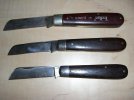Nice knives Dave. There are collectors who would shun examples of knife patterns because they don't grade like a PCGS slabbed coin "Brilliant uncirculated" or "Mint State". I am not one of those. I, obviously like you, enjoy the idea of having a wide spread of examples of a pattern to see the production changes over the years, and the affordability of lesser grade knives. Yes, most of us also have a fair share of those higher grade knives, but there is still much to be learned from a set of used ones.
Sometimes we, as collectors of all ilks and with vastly differing interests and purchase budgets, forget that knives were/are first and foremost tools meant to be used. Many of the old survivors have seen varying degrees of use, some being recycled by reshaping the blades or blade and handle replacement. Many knives like these are culls from other collectors who are upgrading their collections to more pristine examples, though a few are seeing their first rounds of the modern resale market.
Being a used older knife, it takes a really close examination to determine what features were intentional original manufacturing changes and which are artifacts of repair work. Most reshaping and changes I have seen were apparently done to put a knife back into service, rather than in an attempt to deceive a modern collector into paying a higher price for an oddity, though a good amount of that is now taking place.
I have to smile when I see a serious collector display a large array of very early marked knives with no spots or blemishes knowing that a good percentage are obviously "Kentucky mint" (deeply refinished) or "Bretted" (remanufactured with even new blades welded to old tangs). I smile but say nothing. If it makes them happy to own them, more power to them.
And I do have some which have been repaired or refinished, don't get me wrong. It is just that the majority of my knives show varying degrees of honest wear, even if they are just "sliders", to use a coin collector term again. And I have some that I have customized or had customized. Again, a new life for an old knife.
Another foible of collectors is to jump on sellers (particularly from KnifeBay) who don't accurately describe a knife as to condition, details, or identification. The fact is that a lot of them haven't a clue as to knifeology. A few will outright say so. A few simply say "here is a nice old knife. Buy it". But when sellers mis-identify, miss damage details (obvious to us), or think it unimportant to give a full set of focused closeup photographs (after all, it is just an old knife), we shouldn't automatically take offense and castigate them when our roll of the dice fails to come up sevens. Josephine Blow on the street nowdays is far less likely to have a clue about knives.
An example of this is the last Craftsman #9555 I bought for about ten dollars. Seller mentioned a loose blade. It arrived and the blade can be pivoted nearly 270 degrees. The backspring for that blade is not only broken, but that entire end of the sping is completely missing from the spring stack. I gambled and lost. What did I lose? The price of two happy meals? Now do I pass it on as a cull or do I have the backspring replaced by a repairer/embelisher and keep it for a user (it was purchased to be a user in the first place).
I say enjoy your knives. Have a few embelished or repaired if they need it or if you just desire to do so. And caveat emptor to the new prospective owner when we spin off this mortal coil.
Michael

